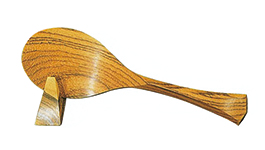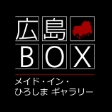Miyajima-zaiku 01[Traditional Crafts designated by the Minister of Economy, Trade and Industry]Miyajima-zaiku Cooperative

| Exhibitor (Manufacturer) | Miyajima-zaiku Cooperative |
|---|---|
| Address | 1165-9 Miyajima-cho, Hatsukaichi City, Hiroshima |
| TEL | (0829)44-1758 |
| Established | Manufacture and sales of Miyajima carvings |
| Job description | 宮島細工の製造・販売 |
| Website | http://miyajimazaiku.com/english/ |
Miyajima-zaiku originates from the techniques used by carpenters working on the restoration of Itsukushima Shrine in the Kamakura period (1185-1333).
In subsequent years, the development of potter’s wheel craft and engraving during the Kaei Era (1848-1855) raised it to the level of an art form, and the four elements of Miyajima-zaiku; Miyajima dippers, Miyajima-bori carving, potter’s wheel craft, and hand-carved trays, were recognized as traditional crafts in 1982.
Miyajima dipper
It is said that the origin of the Miyajima dipper is from the Kansei Period (the Edo Era).
Seishin, an ascetic monk who resettled in Miyajima conveyed the manufacturing method of dippers and these became the specialty product of Miyajima.
Just around the middle of the Meiji Era, not only for souvenirs, but in connection with an increase in demand for daily articles, a full-scale production of Miyajima dippers began through the expansion of a sales route to the Kanasai Region and Miyajima dippers began to be popularized throughout Japan.
Characteristically, “Miyajima dippers” have no odor and rice grains do not stick in addition to their selected materials, artifice of techniques and elegant shape.
Recently, much of the production process has been mechanized, but some craftsmen still manufacture these products by the traditional method and the traditional techniques of “Miyajima dippers” live on even today.


Miyajima-bori
At the end of the Edo Era, Haki Ishosai, a sculptor from Koshu (current Yamanashi) conveyed the technique of wooden carving to Miyajima.
The two major techniques of “Miayjima-bori” are “uki-bori (relief),” which carves flowers and birds in a three-dimensional manner and “shizume-bori (sunk carving),” which carves large shrine gates under a wooden base.
These techniques are known for their characteristic pre sence with the passing of time.
“Miyajima-bori” lives today as specialty and traditional crafts not only in Miyajima but also throughout Hiroshima Prefecture.

Exhibits
・Miyajima-bori, Round Tray 30cm, Itsukushima Shrine worshiping scene
・Miyajima-bori (tree peony)
・Dipper (mulberry)
・Dipper (cherry)





















